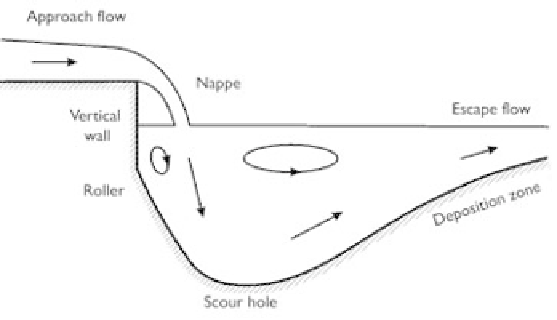Geoscience Reference
In-Depth Information
Figure 7.16
Fluvial and geomorphic features of headcut (side view).
in these formulas depend on soil properties, such as void ratio, moisture content,
saturation degree, bulk density, and clay content (Hanson
et al
., 1997; Wu and Wang,
2005). Kitamura
et al
. (1999) and Wu and Wang (2005) developed numerical models
to simulate the detailed erosion and migration processes of headcut. The numerical
model of Wu and Wang is introduced below.
The flow model introduced in Section 7.1.3.2 with the standard
k
-
turbulence
closure is used to compute the flow in the plunge pool. The jet impingement velocity
and angle are estimated using the empirical formulas proposed by Robinson (1996).
There are three modes of erosion occurring at the headcut. The first mode is the
surficial erosion along the vertical headwall due to the hydraulic shear of flow. The
second mode is the toe erosion due to the development of scour hole in the plunge
pool. After the surficial erosion and toe erosion develop to a certain extent, the head-
wall will exceed the criterion of stability, and a mass failure will occur, which is the
third mode of headcut erosion. In reality, the mass failure occurs periodically, and each
event finishes in a very short period. Its occurrence may be predicted using the stability
models suggested by Barfield
et al
. (1991) and Robinson and Hanson (1994), which
are similar to that for bank failure shown in Fig. 5.17. However, simulating such a
discontinuous phenomenon using a hydrodynamic model is difficult, as the collapsed
block of soil will strongly disturb the flow field in the plunge pool. For simplicity, a
time-averaged headcut migration model is adopted, as shown in Fig. 7.17.
The erosion rate on the headwall surface due to hydraulic shear,
dl
s
ε
s
−
1
), is
/
dt
(m
·
determined by (Wu and Wang, 2005)
⎨
0.0000625
τ
τ
vm
M
,
vm
M
<
8
dl
s
dt
0.000153
τ
M
2
=
(7.71)
0.00238
τ
,
τ
⎩
vm
M
+
vm
vm
M
≥
0.00977
−
8
where
vm
is the maximum shear stress on the headwall surface (pa);
M
is a material-
dependent parameter, related to the soil bulk density
τ
ρ
b
and clay content
p
c
by




